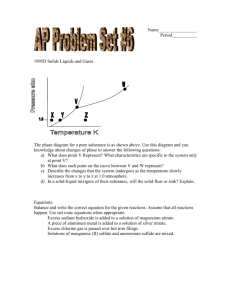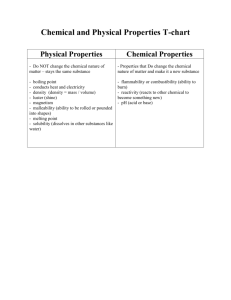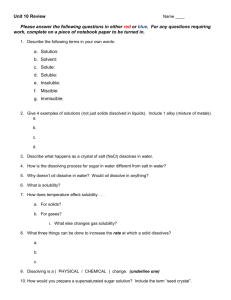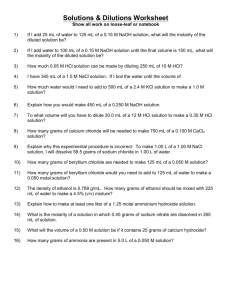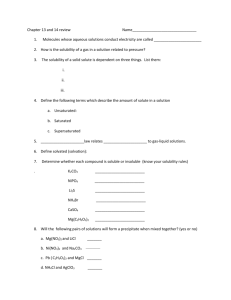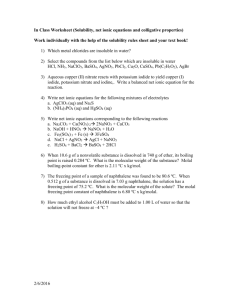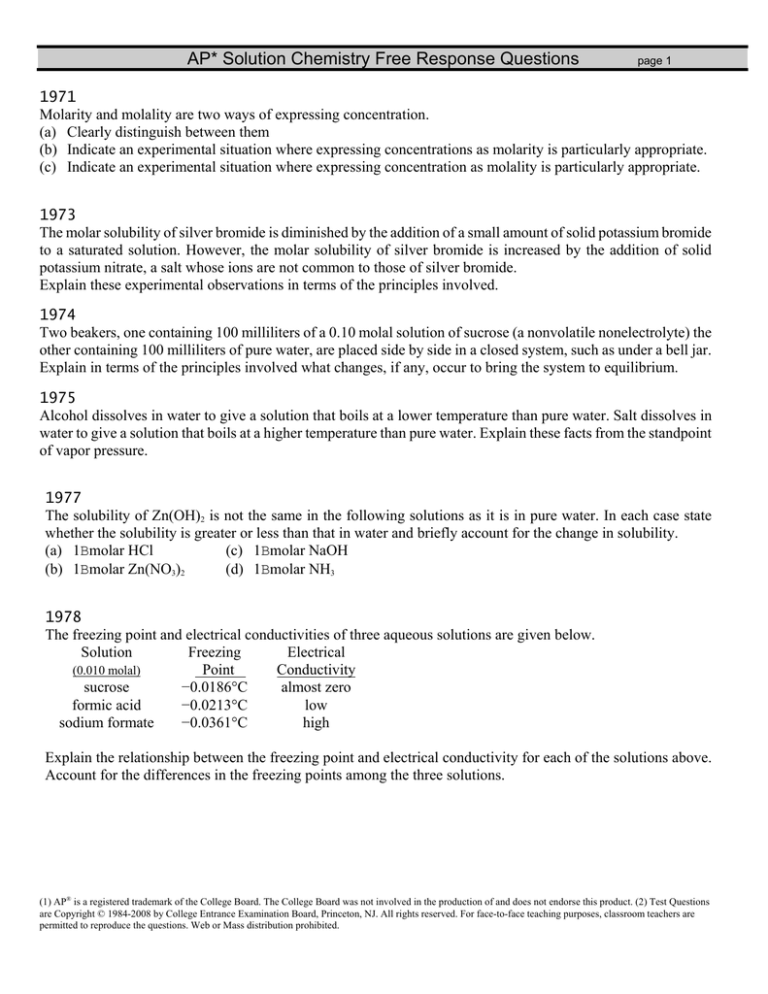
AP* Solution Chemistry Free Response Questions
page 1
1971
Molarity and molality are two ways of expressing concentration.
(a) Clearly distinguish between them
(b) Indicate an experimental situation where expressing concentrations as molarity is particularly appropriate.
(c) Indicate an experimental situation where expressing concentration as molality is particularly appropriate.
1973
The molar solubility of silver bromide is diminished by the addition of a small amount of solid potassium bromide
to a saturated solution. However, the molar solubility of silver bromide is increased by the addition of solid
potassium nitrate, a salt whose ions are not common to those of silver bromide.
Explain these experimental observations in terms of the principles involved.
1974
Two beakers, one containing 100 milliliters of a 0.10 molal solution of sucrose (a nonvolatile nonelectrolyte) the
other containing 100 milliliters of pure water, are placed side by side in a closed system, such as under a bell jar.
Explain in terms of the principles involved what changes, if any, occur to bring the system to equilibrium.
1975
Alcohol dissolves in water to give a solution that boils at a lower temperature than pure water. Salt dissolves in
water to give a solution that boils at a higher temperature than pure water. Explain these facts from the standpoint
of vapor pressure.
1977
The solubility of Zn(OH)2 is not the same in the following solutions as it is in pure water. In each case state
whether the solubility is greater or less than that in water and briefly account for the change in solubility.
(a) 1Bmolar HCl
(c) 1Bmolar NaOH
(b) 1Bmolar Zn(NO3)2
(d) 1Bmolar NH3
1978
The freezing point and electrical conductivities of three aqueous solutions are given below.
Solution
Freezing
Electrical
(0.010 molal)
Point
Conductivity
sucrose
−0.0186°C
almost zero
formic acid
−0.0213°C
low
sodium formate
−0.0361°C
high
Explain the relationship between the freezing point and electrical conductivity for each of the solutions above.
Account for the differences in the freezing points among the three solutions.
(1) AP® is a registered trademark of the College Board. The College Board was not involved in the production of and does not endorse this product. (2) Test Questions
are Copyright © 1984-2008 by College Entrance Examination Board, Princeton, NJ. All rights reserved. For face-to-face teaching purposes, classroom teachers are
permitted to reproduce the questions. Web or Mass distribution prohibited.
AP* Solution Chemistry Free Response Questions
page 2
1980
(a) A solution containing 3.23 grams of an unknown compound dissolved in 100.0 grams of water freezes at
−0.97°C. The solution does not conduct electricity. Calculate the molecular weight of the compound. (The
molal freezing point depression constant for water is 1.86°C kg mole−1)
(b) Elemental analysis of this unknown compound yields the following percentages by weight H = 9.74%;
C = 38.70%; O = 51.56%. Determine the molecular formula for the compound.
(c) Complete combustion of a 1.05 gram sample of the compound with the stoichiometric amount of oxygen gas
produces a mixture of H2O(g) and CO2(g). What is the pressure of this gas mixture when it is contained in a
3.00 liter flask at 127°C?
1980
Account for the differences in solubility described in each of the following experimental observations:
(a) BaCO3, BaSO3, and BaSO4 are only slightly soluble in water, but the first two dissolve in HCl solution
whereas BaSO4 does not.
(b) CuS cannot be dissolved by warm dilute HCl but it does dissolve in warm dilute HNO3.
(c) AgCl, Hg2Cl2 and PbCl2 are only slightly soluble in water, but AgCl does dissolve in ammonia solution
whereas the other two do not.
(d) Fe(OH)3 and Al(OH)3 are only slightly soluble in water, but Al(OH)3 dissolves in concentrated NaOH
whereas Fe(OH)3 does not.
1984
Give a scientific explanation for the following observations. Use equations or diagrams if they are relevant.
(a) It takes longer to cook an egg until it is hard-boiled in Denver (altitude 1 mile above sea level) than it
does in New York City (near sea level).
(b) Burn coal containing a significant amount of sulfur leads to acid rain.
(c) Perspiring is a mechanism for cooling the body.
(d) The addition of antifreeze to water in a radiator decreases the likelihood that the liquid in the radiator
will either freeze or boil.
1985
The formula and the molecular weight of an unknown hydrocarbon compound are to be determined by elemental
analysis and the freezing-point depression method.
(a) The hydrocarbon is found to contain 93.46 percent carbon and 6.54 percent hydrogen. Calculate the
empirical formula of the unknown hydrocarbon.
(b) A solution is prepared by dissolving 2.53 grams of p-dichlorobenzene (molecular weight 147.0) in
25.86 grams of naphthalene (molecular weight 128.2). Calculate the molality of the p-dichlorobenzene
solution.
(c) The freezing point of pure naphthalene is determined to be 80.2°C. The solution prepared in (b) is
found to have an initial freezing point of 75.7°C. Calculate the molal freezing-point depression
constant of naphthalene.
(d) A solution of 2.42 grams of the unknown hydrocarbon dissolved in 26.7 grams of naphthalene is found
to freeze initially at 76.2°C. Calculate the apparent molecular weight of the unknown hydrocarbon on
the basis of the freezing-point depression experiment above.
(e) What is the molecular formula of the unknown hydrocarbon?
AP* Solution Chemistry Free Response Questions
page 3
1987
In 1884 the Swedish chemist Svante Arrhenius proposed that salts dissociate into two or more separate,
independent, ionic fragments when they dissolve in water.
(a) Give one piece of experimental evidence that more than 1 mole of particles is formed when 1 mole of a
salt dissolves in water.
(b) Give one piece of experimental evidence that the particles formed when a salt dissolves in water are
charged.
(c) Explain why the heat of neutralization is always the same when 1 mole of any monoprotic strong acid
reacts with enough strong base to form a neutral solution.
(d) Explain why hydrogen chloride, HCl, dissociated when it dissolves in water but not when it dissolves in
benzene.
1988
The normal boiling and freezing points of argon are 87.3 K and 84.0 K, respectively. The triple point is at 82.7 K
and 0.68 atmosphere.
(a) Use the data above to draw a phase diagram for argon. Label the axes and label the regions in which the
solid, liquid and gas phases are stable. On the phase diagram, show the position of the normal boiling
point.
(b) Describe any changes that can be observed in a sample of solid argon when the temperature is increased
from 40 K to 160 K at a constant pressure of 0.50 atmosphere.
(c) Describe any changes that can be observed in a sample of liquid argon when the pressure is reduced
from 10 atmospheres to 1 atmosphere at a constant temperature of 100 K, which is well below the
critical temperature.
(d) Does the liquid phase of argon have a density greater than, equal to, or less than the density of the solid
phase? Explain your answer, using information given in the introduction to this question.
1989
Consider three unlabeled bottles, each contain small pieces of one of the following metals.
Magnesium
Sodium
Silver
The following reagents are used for identifying the metals.
Pure water
A solution of 1.0 molar HCl
A solution of concentrated HNO3
(a) Which metal can be easily identified because it is much softer than the other two? Describe a chemical
test that distinguishes this metal from the other two, using only one of the reagents above. Write a
balanced chemical equation for the reaction that occurs.
(b) One of the other two metals reacts readily with the HCl solution. Identify the metal and write the
balanced chemical equation for the reaction that occurs when this metal is added to the HCl solution.
Use the table of standard reduction potentials (attached) to account for the fact that this metal reacts
with HCl while the other does not.
(c) The one remaining metal reacts with the concentrated HNO3 solution. Write a balanced chemical
equation for the reaction that occurs.
(d) The solution obtained in (c) is diluted and a few drops of 1 M HCl is added. Describe what would be
observed. Write a balanced chemical equation for the reaction that occurs.
AP* Solution Chemistry Free Response Questions
page 4
1994
Discuss the following phenomena in terms of the chemical and physical properties of the substances involved and
general principles of chemical and physical change.
(a) As the system shown above approaches equilibrium, what change occurs to the volume of water in
beaker A? What happens to the concentration of the sugar solution in beaker B? Explain why these
changes occur.
(b) A bell jar connected to a vacuum pump is shown above. As the air pressure under the bell jar
decreases, what behavior of water in the beaker will be observed? Explain why this occurs.
(c) A water solution of I2 is shaken with an equal volume of a nonpolar
solvent such as TTE (trichlorotrifluoroethane). Describe the appearance
of this system after shaking. (A diagram may be helpful.) Account for
this observation.
AP* Solution Chemistry Free Response Questions
page 5
1994
For each of the following, use appropriate chemical principles to explain the observation.
(a) Sodium chloride may be spread on an icy sidewalk in order to melt the ice; equimolar amounts of
calcium chloride are even more effective.
(b) At room temperature, NH3 is a gas and H2O is a liquid, even though NH3 has a molar mass of
17 grams and H2O has a molar mass of 18 grams.
(c) C (graphite) is used as a lubricant, whereas C (diamond) is used as an abrasive.
(d) Pouring vinegar onto the white residue inside a kettle used for boiling water results in a
fizzing/bubbling phenomenon.
1995
The phase diagram for a pure substance is shown above. Use this diagram and your knowledge about changes of
phase to answer the following questions.
(a) What does point V represent? What characteristics are specific to the system only at point V?.
(b) What does each point on the curve between V and W represent?
(c) Describe the changes that the system undergoes as the temperature slowly increases from X to Y to Z at
1.0 atmosphere.
(d) In a solid-liquid mixture of this substance, will the solid float or sink? Explain.
AP* Solution Chemistry Free Response Questions
page 6
1995
Lead iodide is a dense, golden yellow, slightly soluble solid. At 25°C, lead iodide dissolves in water forming a
system represented by the following equation.
ΔH = +46.5 kilojoules
PbI2(s) → Pb2+ + 2 I−
(a) How does the entropy of the system PbI2(s) + H2O(l) change as PbI2(s) dissolves in water at 25°C? Explain
(b) If the temperature of the system were lowered from 25°C to 15°C, what would be the effect on the value of Ksp?
Explain.
(c) If additional solid PbI2 were added to the system at equilibrium, what would be the effect on the concentration
of I− in the solution? Explain.
(d) At equilibrium, ΔG = 0. What is the initial effect on the value of ΔG of adding a small amount of Pb(NO3)2 to
the system at equilibrium? Explain.
1998
Answer each of the following using appropriate chemical principles.
(a) Why does it take longer to cook an egg in boiling water at high altitude than it does at sea level?
(b) When NH3 gas is bubbled into an aqueous solution of CuCl2, a precipitate forms initially. On
further bubbling, the precipitate disappears. Explain these two observations.
(c) Dimethyl ether, H3C-O-CH3, is not very soluble in water. Draw a structural isomer of dimethyl
ether that is much more soluble in water and explain the basis of its increased water solubility.
(d) Identify a chemical species that is
(i) capable of oxidizing Cl¯(aq) under standard conditions
(ii) capable of reducing Cl2(aq) under standard conditions. In each case, justify
your choice.
2003
For each of the following, use appropriate chemical principles to explain the observations. Include chemical
equations as appropriate.
(a) In areas affected by acid rain, statues and structures made of limestone (calcium carbonate) often show
signs of considerable deterioration.
(b) When table salt (NaCl) and sugar (C12H22O11) are dissolved in water, it is observed that
(i)
both solution have higher boiling points than pure water, and
(ii)
the boiling point of 0.10 M NaCl(aq) is higher than that of 0.10 M C12H22O11(aq).
(c) Methane gas does not behave as an ideal gas at low temperatures and high pressures.
(d) Water droplets form on the outside of a beaker containing an ice bath.

